4.5.2 -
The early hours of the 12th are occupied by a period of weather photography. The idea was to photograph the globe at roughly 20 minute intervals. The exact reasons for it are given in the introduction, and relates to tying the images to ATS imagery. The transcripts record the build up:
007:17:05 Lovell: Roger. We're at that stage now where we're going to take some Earth weather photography. If you're standing by, I have the camera aimed at the Earth right now, and I'll give you a mark when I take the first picture.
007:17:19 Brand: Roger. We copy, Jim. We'll be standing by for the mark. [Long pause.]
007:17:41 Lovell: Okay, Houston. 3, 2, 1...
007:17:45 Lovell: Mark.
The first image was taken at exactly 02:30:45. The next image of Earth in magazine 60 is AS13-
Figure 4.5.2.1 shows this image, and figure 4.5.2.2 the satellite image comparison.
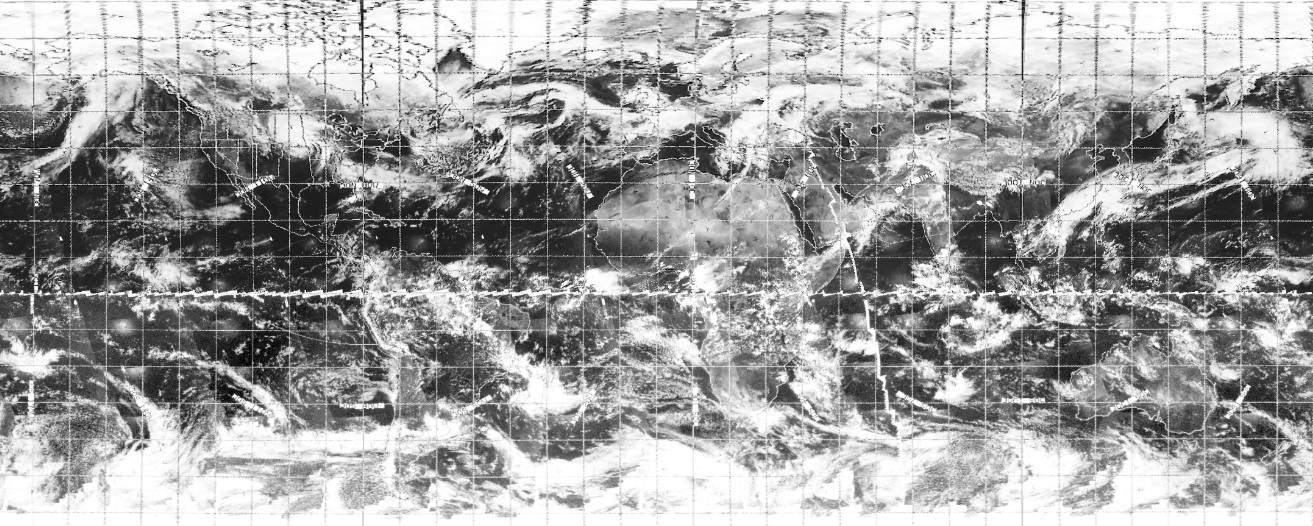

Figure 4.5.2.1: AS13-
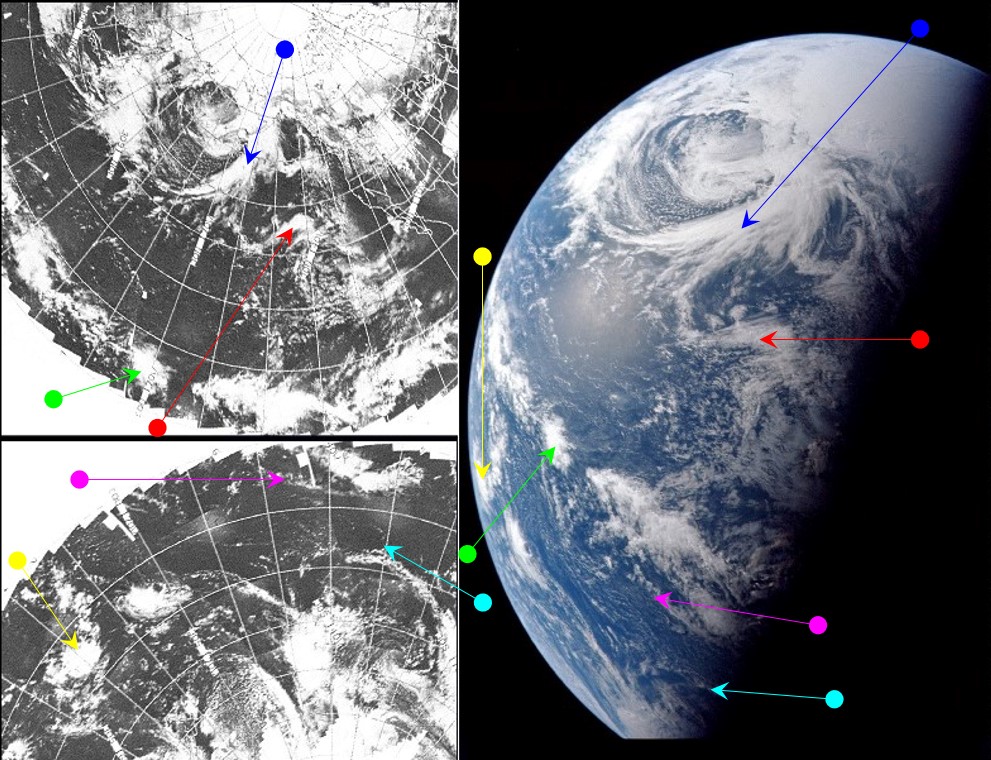
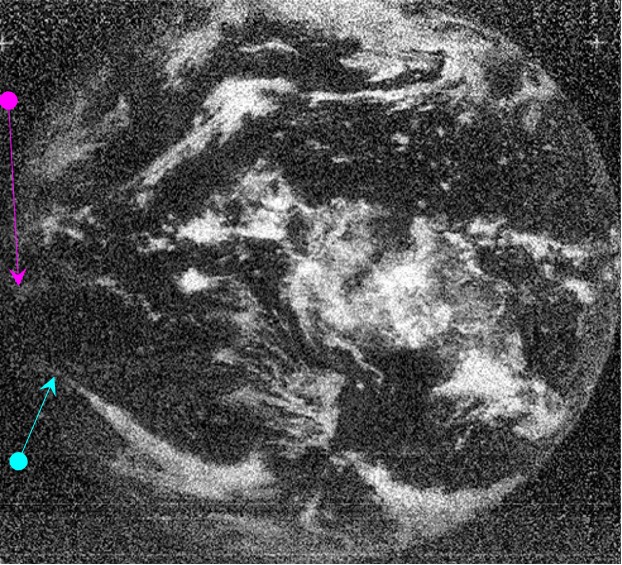

Figure 4.5.2.2: AS13-
The weather system identified by the red arrow is clearly the same as that in figure 4.5.1.8 and the clouds picked out by the blue arrow, although not identified specifically in the preceding analysis, is very obviously the same one.
Land masses are not readily obvious in either SkySafarior the Apollo image (which in itself is an indicator that the time for both is correct), but for those that wish to zoom in close enough, land is visible through the cloud cover towards the top of the globe, at what would correspond with north-
We already know the time of the ATS image, and the Earth as far as Apollo is concerned has evidently moved on since it was taken. ESSA's orbit covering the north Pacific best here is track number 6, or pass 5117, commenced at 00:03 on the 12th, so the Apollo image was taken within a few hours of the satellite version.
The next image was taken just 22 minutes later, so there’s little point in doing a complete analysis of it. However, we can show that it has changed orientation, and that Earth is a genuine, rotating object in space. Figure 4.5.2.3 shows the image, and a comparison of an area of terminator between this one and the one above. As before, Lovell cues us in:
007:39:26 Lovell: Stand by for another Earth weather picture. I'll give you a mark.
007:39:29 Brand: Okay. Standing by, Jim. [Long pause.]
007:39:46 Lovell: 3, 2, 1 ...
007:39:49 Lovell: Mark.
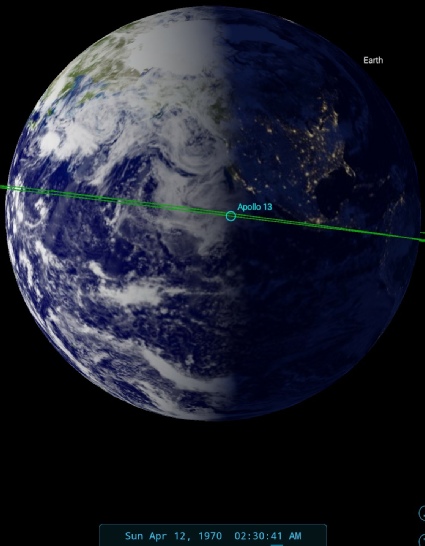

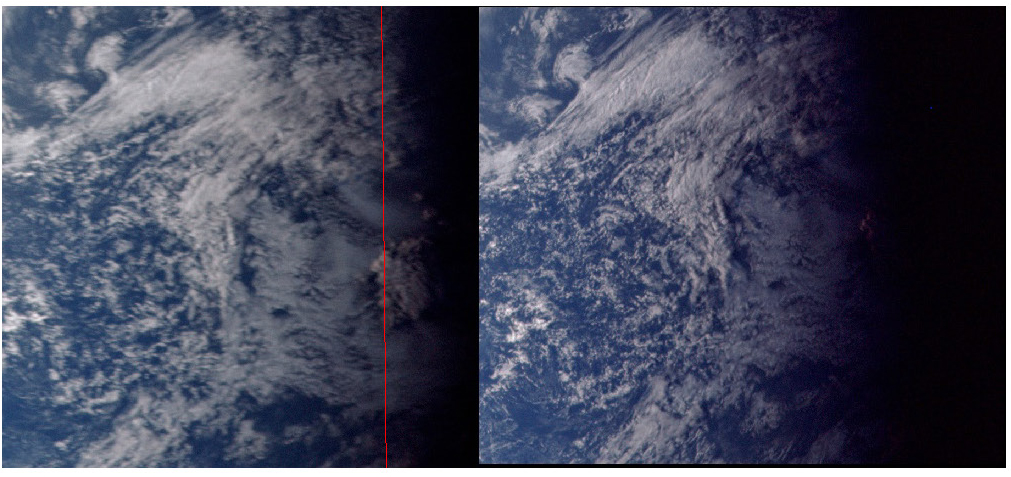
It is quite obvious from these two images that the Earth has moved, and moved roughly the sort of distance you would expect it to have moved in around 20 minutes – roughly 5 degrees of longitude, or around 400 km at the latitude of the clouds chosen.
There is a much longer gap than was intended between this image and AS13-
008:10:46 Haise: And Vance, on that picture, I was all set to shoot it just a little before you called, and the Earth hasn't showed up in the window yet. I don't know if we got too far off the bellyband or what.
but it was resumed again later:
008:41:53 Haise: Okay. Ready for a little count here, Vance, and I'll shoot another picture. We found the Earth again.
008:41:59 Brand: Okay. We'll be standing by, Fred.
008:42:05 Haise: Okay. 3, 2, 1...
008:42:09 Haise: Mark.
008:42:11 Brand: Roger. Copy.
Figure 4.5.2.4 shows the next image in the sequence.
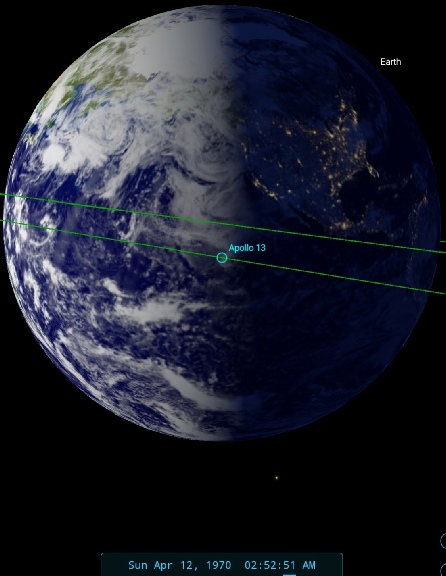
Figure 4.5.2.3: Section of AS13-


Figure 4.5.2.4: AS13-
The distinction weather sequence is now much closer to the terminator, but again there isn’t any need to reproduce all the satellite imagery.
Image number 4 in the sequence is shown in figure 4.5.2.5.
009:02:52 Haise: Okay. Stand by for a mark on another picture.
009:02:55 Brand: Okay. Standing by, Fred. [Long pause.]
009:03:09 Haise: 3, 2, 1...
009:03:12 Haise: Mark.
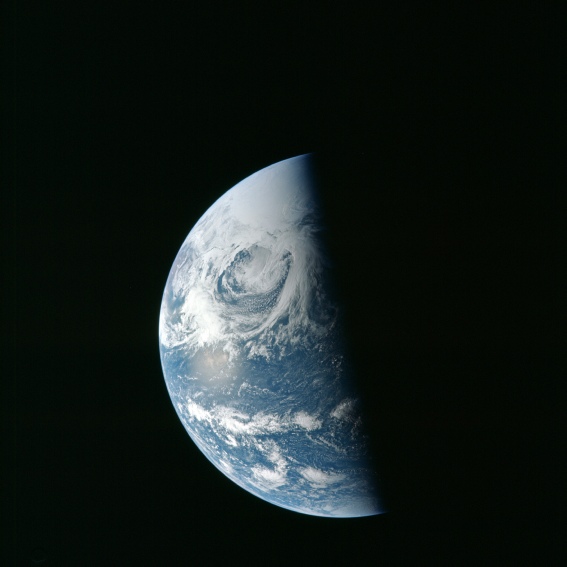

Figure 4.5.2.5: AS13-
Next up, AS13-
009:26:19 Haise: Okay. And, Houston, stand by for a mark on another picture.
009:26:24 Brand: Rog. Standing by.
009:26:33 Haise: 3, 2, 1...
009:26:36 Haise: Mark it.


Figure 4.5.2.6: AS13-
The next image is marked by Haise’s timer.
009:46:26 Haise: Yeah. I guess so. In a minute, you're going to hear my kitchen timer ding, and that also says the Earth is there.
009:46:39 Brand: Okay. [Long pause.]
009:46:57 Haise: Okay. Stand by, Vance, for our countdown. [Pause.]
009:47:09 Lovell: 3, 2, 1...
009:47:12 Lovell: Mark.
Figure 4.5.2.7 has the details.

Figure 4.5.2.7: AS13-
Figure 4.5.2.8 shows number 7, with this record in the transcript as capcom remind them it’s almost time.
010:08:02 Brand: The Earth's coming up in the window again in 1 to 2 minutes.
010:08:08 Swigert: He's got it. You're right again. [Long pause.]
010:08:24 Swigert: Okay, stand by for a mark here.
010:08:26 Brand: Rog. [Long pause.]
010:08:38 Swigert: Okay, ready? 3, 2, 1...
010:08:40 Swigert: Mark.



Figure 4.5.2.8: AS13-
Figure 4.5.2.9 shows the next one:
010:29:56 Brand: Okay, Earth should be coming into view.
010:30:01 Haise: Okay. I got it. [Long pause.]
010:30:56 Swigert: Okay. Stand by, Vance. 3, 2, 1...
010:31:01 Swigert: Mark.

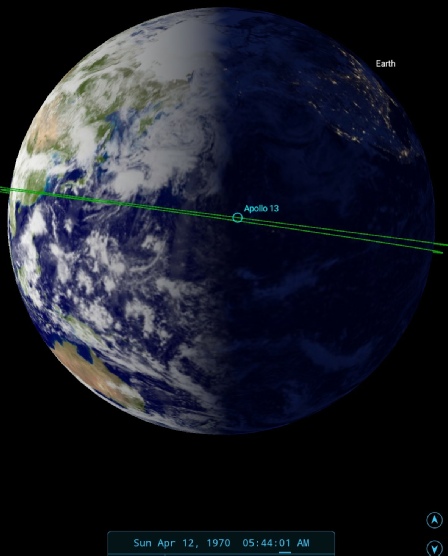
Figure 4.5.2.9: AS13-
As is evident from the photos, Earth is gradually shrinking with the increasing distance, and Capcom asks them about the view:
010:31:14 Brand: Earth starting to look pretty small now?
010:31:23 Swigert: Well, looking at here, Vance, it's hard to be convinced it's even the Earth. All we see is water and clouds. [Pause.]
010:31:36 Brand: Well, I guess that's what we want. We want pictures of weather, right, clouds.
010:31:43 Swigert: Yeah, about half of it's covered with clouds.
Which indeed it is.
20 minutes later we have a reminder to take the next photograph.
010:51:33 Brand: Apollo 13, Houston.
010:51:37 Swigert: Go ahead, Vance.
010:51:40 Brand: Time to look out your window for us again.
010:51:46 Swigert: Lo and behold.
010:52:58 Swigert: Okay. It's 3, 2, 1...
010:53:01 Swigert: Mark.
Figure 4.5.2.10 has the details.


Figure 4.5.2.10: AS13-
The penultimate image is AS13-
011:13:56 MCC: You should have the Earth coming into view here shortly.
011:14:02 Swigert: Okay. [Pause.]
011:14:12 Haise: We got a new CapCom now. [Long pause.]
011:14:29 Brand: No, I changed my voice. [Long pause.]
011:14:58 Haise: 3, 2, 1...
011:15:01 Haise: Mark.

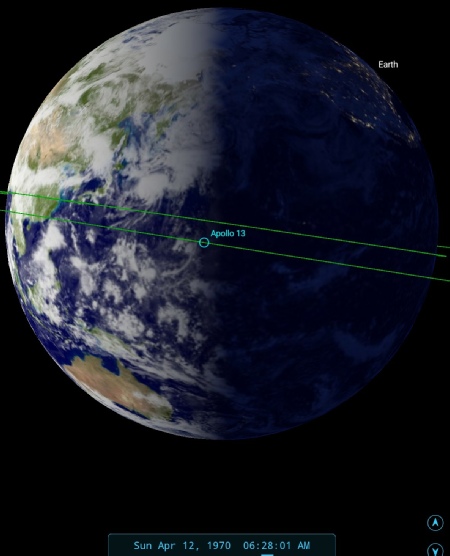
Figure 4.5.2.10: AS13-
After this last image, we have some discussion about what they’re looking at:
011:16:59 Haise: I guess the world really does turn. I can see some of my landmasses now. It must be Australia down near the bottom and I guess we haven't really figured out what's over the -
011:17:19 Brand: Hey, maybe the fact that you verified that the Earth really turns, we can call this Haise's Theory, huh? [Pause.]
011:17:32 Haise: Very good, Vance. Very good.
011:17:36 Lovell: It's looking good for you, Vance.
011:17:39 Brand: No, seriously. Very interesting, we can see on the map now that you're between Guam and Hawaii and a little bit north, and you're almost out 60,000 miles [110,000 km].
As always, the view is completely accurate.
While the original plan was to take 10 images, the crew are requested to take one more for luck, and the moment is recorded as follows:
011:35:34 Brand: Okay, Jack, this is the last time for the Earth coming into view in about 1 to 2 minutes.
011:35:43 Swigert: Okay. I got my photographer looking out there.
011:35:47 Brand: Okay. [Long pause.]
011:35:59 Brand: 13, Houston. I just corrected. Actually, the Earth will come into view more times. It's just that we're [garbled] to the photography. Over.
011:36:12 Swigert: Okay.
Comm break.
011:37:17 Haise: 3, 2, 1...
011:37:20 Haise: Mark.
Figure 4.5.2.11 shows this final photograph, and now that we’re at the end of the sequence it’s worth doing a full analysis, which is shown in figure 4.5.2.12.
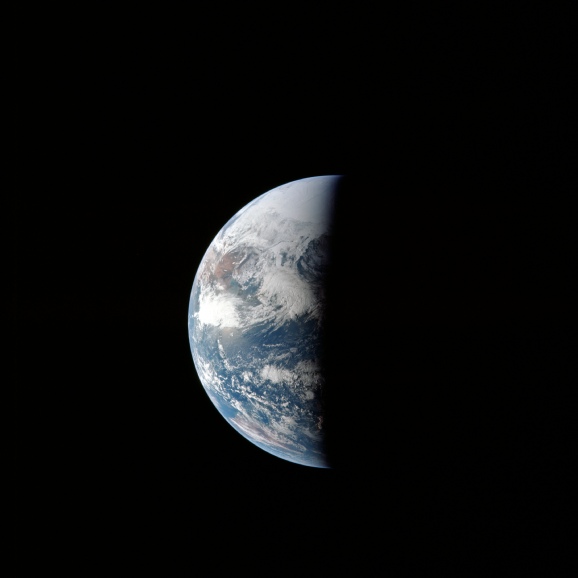
Figure 4.5.2.11: AS13-
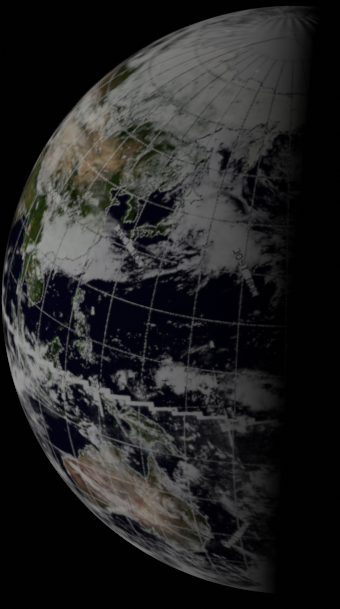
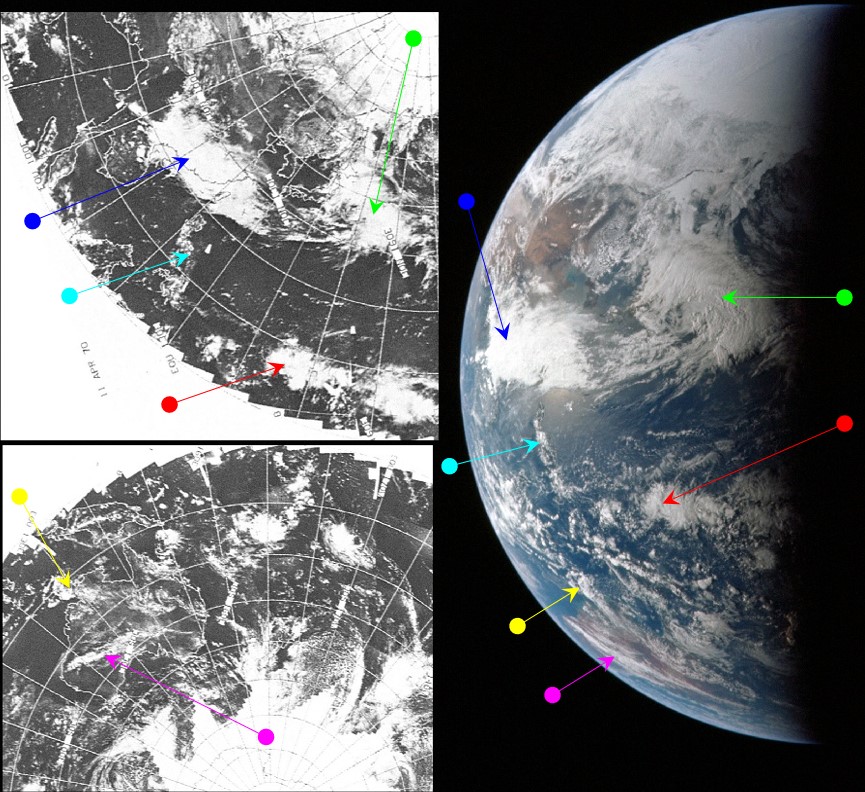

Figure 4.5.2.12: AS13-
As by this time the viewpoint of ATS-
The cloud mass identified by the green arrow is the one to the west of the system picked out in blue in figure 4.5.6, and the red arrowed band of cloud is a continuation of the one picked out in green in figure 4.5.2.2. As for whether ESSA's timings can confirm the time given by the Apollo mission and SkySafari, the most relevant track is number 8, which corresponds to pass 5119, commenced at 04:04 on the 12th. Again, ESSA's pass over Australia falls within a couple of hours of the Apollo image.
If the sequence of photographs taken by Apollo 13 as the earth recedes behind it are strung together as a video, the result can be seen below:
The rotational movement over the sequence is undeniable.
Sadly for the scientists, the comparison the wind speed and cloud height comparisons they wanted to perform against ATS imagery were inconclusive, and it didn’t help that, as the mission report states:
“The Advanced Technology Satellite I was out of operation on the day of photography”
The views of Earth, however, are definitely correct.
There is a considerable time lapse between these images and the next photographs of Earth, which is hardly surprising given that other events in the mission preoccupy them somewhat. The TV broadcast on the 13th doesn’t show Earth, and it’s day 4, the 14th, before we next see Earth photographs.